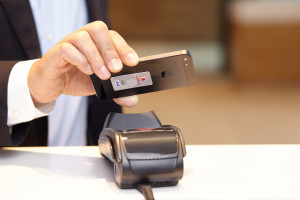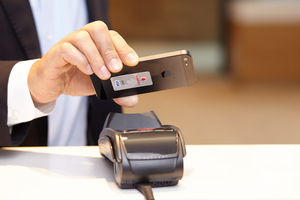Apple Pay may not be dominating mobile payments, but it is definitely dominating the mobile payments news cycle. But some retailers have been reluctant to add Apple Pay to their list of payment options.
This hesitance to adopt NFC payments is not motivated by a fear of new technology; rather, it’s a desire to dominate this new payments niche. More and more, retailers are showing interest in growing the user base for their own in-house customer apps, and including payments in the app helps them do that.
People Are Paying With Retailer Apps
 Retailers have been moving into mobile POS payments with more success than they get the press for. Many large retailers are finding that a customer app including payments, discounts, and rewards programs can improve customer experience and increase customer loyalty.
Retailers have been moving into mobile POS payments with more success than they get the press for. Many large retailers are finding that a customer app including payments, discounts, and rewards programs can improve customer experience and increase customer loyalty.
In fact, far more people use the Starbucks app to buy their coffee in the morning than use Apple Pay to buy anything at all. Dunkin’ Donuts makes a strong showing as well. Other retailers want to duplicate that success using their own apps.
Many large nationwide retailers including Wal-Mart, Target and CVS are not on board with ApplePay, and have even taken some heat in the press for it. The thing that these competing retailers have in common is their partnership in MCX, the Merchant Customer eXchange.
Wal-Mart Battles Visa
MCX is a consortium of dozens of large corporate retailer members. MCX has been working on its own mobile payments system, CurrentC, which is a direct competitor to Apple Pay in the mobile payments arena.

CurrentC attempts to straddle the divide between monopolistic aggregators like Apple Pay and isolated retail apps like Starbucks. CurrentC aggregates customer and payment information, granting member businesses permissioned access to this information for their own apps and at the point of sale.
Member companies are refusing to integrate Apple Pay because MCX feels it undermines their own efforts. MCX went so far as to instruct member companies to disable NFC on their payment kiosks, signaling an intent to use members’ retail outlets in an isolationist fashion to promote their own payment system.
Crucially, CurrentC completes payments using the customer’s checking account, store cards or gift cards – not credit cards. Using these payment methods benefits retailers by eliminating the percentage retailers must kick back to payment processors. To MCX, ApplePay represents not just a competing payment system, but another means for credit card companies to extract fees from their businesses.
How excluding credit cards benefits customers is unclear. In fact, consumers prefer to use credit cards, especially for transactions perceived as riskier. Consumers enjoy the protection credit cards offer against fraud, and they are attached to their credit card loyalty programs.
The Real Honey Pot: Customer Data
Providing their own payment app benefits the retailer by reducing their payment processing fees. But the benefits extend beyond the transaction itself, as the data collected on consumer behavior is much more valuable in the long term.
Retailers tend to guard this information closely. Handing over payments to an aggregator could mean buying that data from them in the future. On the other hand, partnering with an aggregator might offer retailers a chance to increase the customer data available to them. CurrentC’s integration with retailer apps is a key feature in this regard.
But if retailers don’t see any benefits from partnering up, they may just decide to skip it and build their own.
